Abstract
Twenty or thirty years ago the serve in a tennis game was used only to put the ball in play and not to gain points. Therefore, serve practicing was significantly reduced. Over time, there have been trainers and players who overseen solutions in order to increase the serve efficiency: using particular effects to misguide the opponent; growing the serve hitting power expecting to get direct points (aces); net attack in order to finalize the action by a volley or smash; expanding the serve practice. Nowadays, as technique, methodology and equipment have improved, the old role of the serve is surpassed, today being considered to be a winner includes incorporately the basic hits category. Improving the basic technical elements, serve included, is a key to the whole preparation process, and has great influence over the players’ success rate in training and competitions. The methodology of improving basic elements must be part of the training, an essential condition of the game, which cannot be substituted by any other technique or tactics. In today’s tennis, one can win direct points in a game if the serve is efficient. In children, in order to become effective, the serve must be improved step by step, using technical procedures.
Keywords: ChildrenTennisServeMethodologyTechniqueTactics
Introduction
Most experts consider serve as a basic shot in tennis. Therefore, it is important to be aware of the serve improvement methodology in children. Tennis is a game between two players or two teams of players who send the ball over a net with the help of the rackets. Strength and conditioning or influence of fatigue on limb muscle activity and performance being intensely studied (Reid, Crespo, Lay &Berry, J., 2007; Reid & Schneiker, 2008; Rota, Morel, Saboul, Rogowski, Hautier, 2014; Rota, Hautier, Creveaux, Champely, Guillot & Rogowski, 2012). "Sports technique is a process or a combination of processes learned through practice in order to economically and efficiently complete a certain task based on movement, in other words it is a movement task” (Baciu, 2008, p.5). By tennis technique we understand all the processes used to play the game efficiently (Koopman, Berger, Hoekstra & de Groot, 2016). The serve is used to put the ball in motion at the beginning of every game (Moise, Moise & Dobosi, 1995, p.37). Also, the serve in tennis is a technical process that can allow the winning of many points and even can decide on victory" (Moise & Moise, 1999, p.127).
Problem Statement
On this topic, authors are giving a great importance to the kinematic processes linked with (Whiteside, Elliott, Lay & Reid, 2013; 2014) the biomechanics of movements in tennis (Alizadehkhaiyat & Frostick, 2015; King, Kentel & Mitchell, 2012).
"With bigger, stronger athletes, more powerful racquets, a total precision in body mechanics, the serve arsenal today is often equipped with a "sonic boom "first serve capable of eclipsing 140 miles per hour" (Bollettieri, 2001, p.137). This is also available and studied for the younger aged tennis player category (Schluga Filho, Romanovitch Ribas, Oliveira Nogueira, Andrade, Fernandes & Bassan, 2016).
The technical processes have four basic moments, each of them enabling their development: preparation mechanism; preparation mechanism for hitting the ball (Whiteside, Elliott, Lay & Reid, 2013); the mechanism for hitting the ball; the mechanism for completing the ball hitting" (Moise & Moise, 1999, pp.25-26).
The serve technique implies the following sequences: basic position; racket grip; shot preparation; shot; shot end. The serve as a basic technical element of the tennis game can be performed using the following technical procedures: semi pendulum (Figure

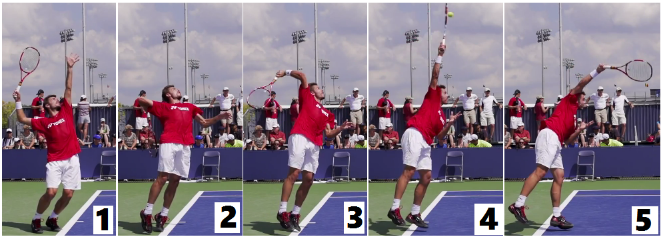
For the slice serve, at the impact moment, the ball is hit from left to right and above the sweet spot from the top to the bottom. For the top spin serve, the ball is hit under the sweet spot from left to right from the bottom to the top. For the flat serve, the ball is fully hit, the racket upright in the flying direction of the ball. Regarding the hitting point of the ball when serving, there are different opinions, but, in our opinion, there are three different positions depending on the serve we use, namely:
- slice and flat serve, the ball must be hit at the highest point when flying on the trajectory;
- slice serve, the ball must be hit immediately when it starts going down from the highest point.
Matsuzaki (2004) associates the striking point of the ball in flat, slice and top spin serve for both right-handed and left-handed players with the hours of the watch (Figure
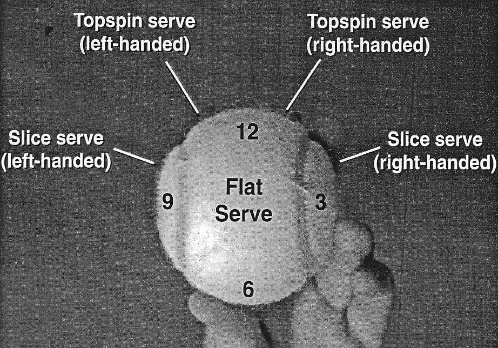
Tennis is a sport for all children, when regularly played it offers benefits for health associated with physical and mental development. Between 12-14 years, the children play single and double tennis on normal court, using a yellow ball and a regular racket (Schluga-Filho et al., 2016).
Success in tennis depends on several physicals, technical/tactics and psychological factors (Fernandez-Fernandez et al., 2009). "By tactics, we mean all player’s actions are rationally organised and coordinated, within the bounds of the regulations and sports spirit, in order to take advantage of his/her own qualities and of the opponent’s weak points" (Baciu, 2008, p.26).
"The tactics of a single game has the following content:
- fix moments rally and components;
- alternative moments rally and components;
- decisive moments and components;
- crossing moments and components" (Moise & Moise, 1999, p.27).
The serve and the return are part of the first phase when disputing the point in a single game. The tactic content of the serve is determined by direction and length of the shot, the trajectory, the speed and effect given to the ball, the precision of the shot, the player’s placement and the placement of the shot.
Regarding the regulations, the server has the right to two attempts, first and second serve. He or she serves alternatively, to the right and the left court of the opponent, who moves from right to left in order to return the ball. The execution of the two serves allowed by the regulations is performed by using different procedures. Taller players 170 cm and above, perform the two serves using the flat, slice or top spin serve.
Players smaller than 170 cm perform slice or top spin serve.
There is a difference of tactical orientation between the two serves. The first serve allows different executions in terms of force and placement, because, in case of mistake, the player still has an attempt. The second serve is characterised by safety (effect), placement on the weaker side of the opponent and placement closer to the baseline, because it is more difficult to return.
Teaching Method
"Methodology is the science of the method. It is the science that helps the trainer to complete the educational objectives for a certain lesson" (Crespo & Miley, 1998, p.24).
By the method used in order to teach and improve the technique of the tennis game, the trainer has to complete the following tasks:
- forming a correct representation of the element and of the technical procedure he/she teaches;
- correct execution of the movements;
- forming and fixing specific movements;
- improving technique by introducing economic executions, increased speed and relaxation;
- improving technique by greater precision and coordination of movements and activities.
Method orientation when teaching tennis game is based on a series of principles and methods corresponding to those used in physical education and training. "The method implies to present things in a certain order. There is a set of regulations which should be followed in order to get the best results" (Crespo & Miley 1998, p.24).
In tennis, there are three main teaching methods: the global method, the analytical method and the mixed method. When choosing the method, we have to bear in mind: the player’s level, the complexity and the manifestation manner of the ability, and a combo between the player’s level and the teaching goal.
The serve improvement is made in three steps, based on specific goals:
First step: Serve improvement under isolated conditions.
Goal: improving the tactic content.
Second step: Serve improvement in game actions.
Goal: improvement of the player’s placement and of his shots.
Third step: Improvement of theme and a game of verification.
Goal: themes improvement with offensive character in training and in game action.
First step: Serve improvement under isolated conditions
The serve is improved by correcting analytical and global movements of the body parts involved and by getting the capacity to hit the ball with various speeds in a previously established direction specific to the single or double game.
Achieving these goals implies a step by step training with the players, so that they are able to:
- send the ball to one of the halves of the opponent’s court;
- send the ball to one of the three zones of the opponent’s court;
- send the ball to the other court with variable dimensions (1.5 x 1.5 m) – 1 x 1m; 0.5 x 0.5 m; 0.25 x 0.25m).
For the safety of the serve, it is important for players to be able to perform at least two serves: flat and top spin, flat and slice, top spin and slice.
The ball thrown improves when serving (Figure
Goal: a total of 20 accurate throwing, the ball landing on the surface of the racket.
Method: throwing the ball with stretched arm vertically from the shoulder.
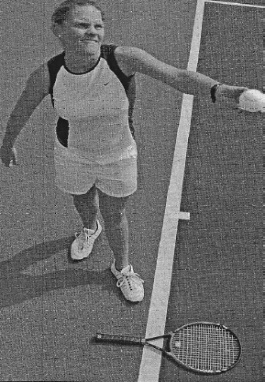
The shot improvement for the racket arm (Figure
Goal: a total of 20 accurate executions.
Method: full extent of the arm racket towards the ball hung on the fence.
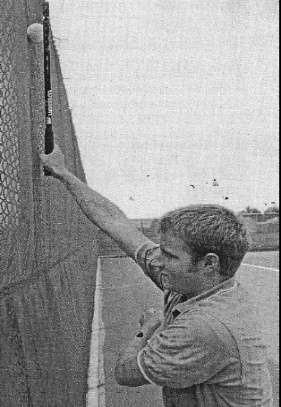
Imitation exercises: imitations of racket grip and of pendulum serve (Figure
Goal: a total of 20 accurate serve.
Method: use of continental grip and of correct movements of the body parts involved in serve.
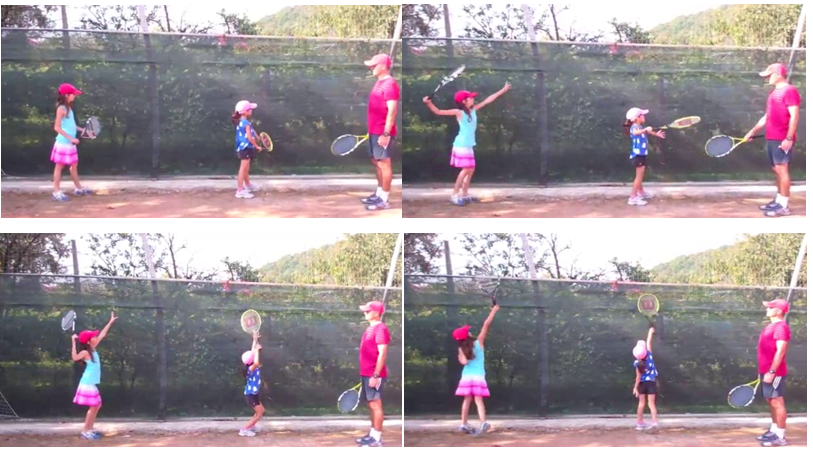
Target serves (Figure
Goal: a total of 20 accurate strikes.
Method: first serve – flat serve, second serve – top spin or slice.
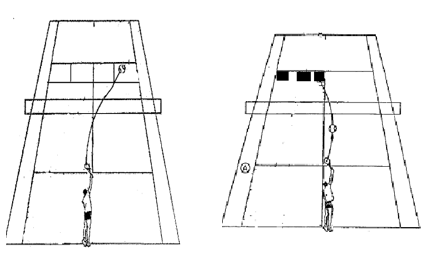
Second step: Serve improvement in game actions
According to the steps regarding the playing of the point in a single game, the serve can be a combination and there are the following actions:
Service 1, service 2 - return (Figure
Goal: a total of 20 accurate shots.
Method: first serve - flat, to the T or in the middle, second serve - slice or flat, to the T or in the middle.
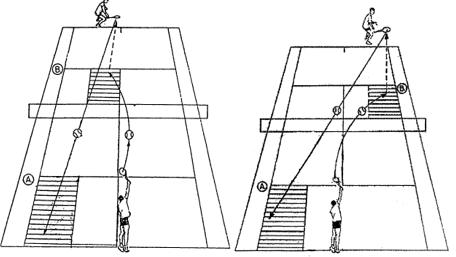
Serve attack - return-volley (Figure
Goal: 8 accurate attacks out of 10 attempts. Method: move forward to the net when hitting, stop, split-step.
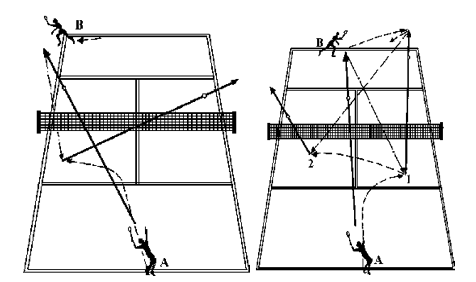
Serve - return- decisive shot down the line (Figure
Goal: a total of 20 accurate shots. Method: first serve - flat, to the T or in the middle, second serve - slice or top spin, to the T or in the middle, return – cross, decisive shot down the line.
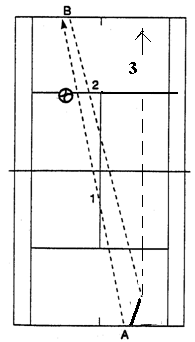
Third step: Improvement of theme and a game of verification.
The themed games are an efficient means of training, checking the technical and tactical capacity of the player. For the first and the second serves, the themes must have different content, offensive character and focus on the tactic content of both shots. Themes can be used in: a game, set, tie - break, disadvantage games (points, games, sets, number of players, and the surface of the court).
Themes of serve:
- first serve - flat, down the line in the opponent’s serving court to the T, median or diagonally;- second serve - slice, top spin down the line to the opponent’s serving court and oriented to his/her weak side.
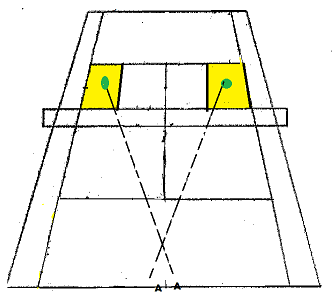
Research Questions
In conducting this study, the findings were constructed from the following three hypotheses:
- Are there significant differences between the results obtained by the subjects with the first serve, initial and final test?
- Are there significant differences between the results obtained by the subjects with the second serve, initial and final test?
- Are there significant differences between the results of the tests of the subjects with the first serve and those obtained with the second serve?
Purpose of the Study
The purpose of the study was to register the results obtained by young subjects and the differences between the first and the second serve. This study aiming to complete, necessary and helpful data about the young tennis players profile.
Research Methods
For this study, the ascertaining study method, the observation method, the method of the practical test, the mathematical-statistical method, the method of the graphic representation, the bibliographic study method and the video recordings about serve technique downloaded from YouTube” processed by Freemake Video Downloader Defragmenter was used.
Subjects
The study involved a group of 12 children (7 girls and 5 boys) between 12-14 years of age, all members of the Tennis School Corbeanca, Romania. The length of the study was 6 months, starting from September 1st 2016 to March 1st 2017.
During the study, the children were divided into two groups and had two training sessions per week.
In order to improve the serve, we used the following stages with specific goals and methods:
Stage 1: Improving the serve under isolated conditions. Goal: improvement of the tactical content.
Methods: improving the throwing of the ball when serving; improving the shot for the racket arm; imitation exercises of racket grip and of pendulum serve; serves to the target zones.
Stage 2: Improving the serve in game actions. Goal: improving the player’s placement and shots.
Methods: serve 1, 2–return; serve attack- return-volley; serve- return- decisive shot down the line.
Stage 3: Improving the serve in themed games and in verification games. Goal: improving the serve in themed games with offensive character, in games of verification.
Methods: trial games; handicapping (points, score, number of players, court); single games; double games and tie-breaks.
Test
There were two tests during the study. The initial test was performed at the beginning of the training period and then there was another test at the end of the training (Figure
The practical test consisted of alternative serve to the opponent’s court from the right side and from the left side to the exterior in the yellow zones (6.40 x 2.05m). First serve is flat. Second serve is top spin or slice. There are ten attempts. The accurate serves are written down, according to the game rules.
Evaluation system: Result: 10-9-8-7-6-5; Grade: 10-9-8-7-6-5 after (Moise & Moise, 1999, p.377).

Organisation
The results obtained by the children in the initial and final test are included in the chart. They are processed by mathematical and statistical methods (arithmetic mean, ratio of variability and amplitude).
Findings
Anthropometric results
The group is formed of 12 children. All 12 were healthy during the trial. The average age of the group is 13.08 years, the youngest was 12, and the oldest was 14. The average height is 151.16 cm. The average weight is 41.33 kg. The body mass index is 18 kg/m2, this is normal, this value indicates that all subjects had normal weight for their age.
Comparative Results
The processing of the data obtained with the first serve, second serve, initial and final test of the mathematical and statistical method (arithmetic mean,
Intragroup review (Table 1)
The highest average performance recorded at the first serve was 3.97; the average value recorded at the second serve was 3.0. The difference 0.91 between the arithmetic means with the initial test for the first and second serve is small.
The highest amplitude value is recorded at first serve was 6.0; the value recorded at second serve was 4.0. Different values of the amplitude 4.0 and 6.0 indicate an inconstant technique of the shot.
The small value of the
The
The comparative results of the processed data for the final testing first and second serve using statistic indicators – mathematical (x = arithmetic mean, w = amplitude,
Intragroup review (Table 2)
The highest average performance recorded at the first serve was 6.50; the average value is recorded at the second serve was 4.33, with a difference of 2.17 between the arithmetic means.
The constant value of the amplitude of the first serve and the second serve was 6.0; thus pointing a constant shot technique.
The small value of the variability
The
As shown in table
Intergroup review (Table 3)
The highest average performance recorded at the first serve initial testing was 3.91; the average value recorded at first serve final testing was 6.50, the arithmetic mean difference for the initial and final testing being 2.59.
The constant value of the amplitude of the first serve was 6.0, indicating a constant technique of the shot, the small value of the
The
As is shown in Table
The highest average performance was recorded at the second serve initial testing 3.0; the average value recorded at the final test was 4.33. There was an insignificant difference 1.33 between the arithmetic means for the initial and final test for the second serve. The highest amplitude value recorded at second final serve was about 6.0 and the value recorded at initial second serve was 4.0, the different values of the amplitude, in this case shows the inconstant shot technique.
The small value of the variability
Conclusion
The results obtained and statistically processed at first serve confirms the working hypothesis, the difference between the arithmetic mean of the results obtained by the subjects being significant. The reduced value of the
The results obtained and statistically processed at second serve confirms also the working hypothesis. The small difference between the arithmetic mean of the results is for the raison in terms of technical execution of the second service is more difficult. The reduced value of the
The comparative analysis between the arithmetic mean with the first serve and the second serve indicates a significant difference and confirms the working premise. The constant value of the amplitude with the first serve indicates a constant technique of the shot by comparison with different values of the amplitude with the second serve, which indicate the fluctuating of the shots technique.
After analysing and comparing the data of the control samples given in the final testing, we found an improvement of the technical and tactical preparation of the first serve compared to the second serve, justified by the number of correct blows. This was due to the methods and exercises learned and practiced by children in the training lessons.
In our eyes, the execution of the second service is more difficult, requiring the maximum concentration and intense work.
As an outcome of this result research and confirming the literature, the coaches who prepare groups of 12-14 years children have to improve both the processes of the serve, not only the first serve that brings immediate satisfaction, but also the second serve in order to be efficient.
References
- Alizadehkhaiyat, O., Frostick, S.O. (2015). Electromyographic assessment of forearm muscle function in tennis players with and without Lateral Epicondylitis. Journal of Electromyography and Kinesiology, 25, 876–886.
- Baciu, M. (2008). Antrenamentul in tenisul de camp. Cluj Napoca: Editura Napoca Star, 5- 26.
- Bollettieri, N. (2001). Bollettieri Tennis Handbook USA: Human Kinetics Publishers, p. 137.
- Crespo, M., Miley, D. (1998). Manualul Antrenorilor Avansati (In Romanian) (ITF Ltd), pp. 24-33.
- Fernandez-Fernandez J., Sanz-Rivas D., Mendez-Villanueva A. (2009) A review of the activity profile and physiological demands of tennis match play. Strength & Conditioning Journal 31(4), 15-26
- King, M.A., Kentel, B.B., Mitchell, S.R. (2012). The effects of ball impact location and grip tightness on the arm, racquet and ball for one-handed tennis backhand ground strokes. Journal of Biomechanics, 45, 1048-1052.
- Koopman, J., Berger, M., Hoekstra, A., de Groot, S. (2016). Exploring different technical solutions of the interface between the hand, racket and the rim in wheelchair tennis. Procedia Engineering, 147, 484 – 489.
- Matsuzaki, C. (2004). Tennis Fundamentals. United States: Human Kinetics Publishers, Inc, p. 90.
- Moise, D., Moise, G. (1999). Tenis Modele de lectii de antrenament pentru pregătirea tehnico-tactică de performanta: Editura Leda Muntenia, Constanţa pp. 25-27, 127, 377.
- Moise, G., Moise, D., Dobosi, S. (1995). Tenis pentru incepatori. Editura Garamond Cluj Napoca, p. 37.
- Moreno-Perez, V., Moreside, J., Barbado, D., Vera-Garcia, F.J. (2015). Comparison of shoulder rotation range of motion in professional tennis players with and without history of shoulder pain. Manual Therapy, 20, 313-318.
- Reid, M., Crespo, M., Lay, B., Berry, J. (2007). Skill acquisition in tennis: Research and current practice. Journal of Science and Medicine in Sport, 10, 1-10.
- Reid, M., Schneiker, K. (2008). Strength and conditioning in tennis: Current research and practice. Journal of Science and Medicine in Sport, 11, 248-256.
- Rota, S., Hautier, C., Creveaux, T., Champely, S., Guillot, A., Rogowski, I. (2012). Relationship between muscle coordination and forehand drive velocity in tennis. Journal of Electromyography and Kinesiology, 22, 294–300.
- Rota, S., Morel, B., Saboul, D., Rogowski, I., Hautier, C. (2014). Influence of fatigue on upper limb muscle activity and performance in tennis. Journal of Electromyography and Kinesiology, 24, 90–97.
- Schluga-Filho, J.L., Romanovitch-Ribas, M., Oliveira-Nogueira, L., Andrade C. Jr., Fernandes, P., Bassan, J.C. (2016). Motor and morphological profile of tennis players from 11 to 15 years old. Revista Andaluza de Medicina del Deporte, 9(3),114–118.
- Whiteside, D., Elliott, B., Lay, B., Reid, M (2013). A kinematic comparison of successful and unsuccessful tennis serves across the elite development pathway. Human Movement Science, 32, 822–835.
- Whiteside, D., Elliott, B., Lay, B., Reid, M. (2014), The effect of racquet swing weight on serve kinematics in elite adolescent female tennis players. Journal of Science and Medicine in Sport 17, 124-128.
- https://youtu.be/-u2ZZhnEG1Y Beginner serve technique. [accessed April 10, 2017].
- https://www.youtube.com/watch?v=o0mkMsVSdrE Stanislas Wawrinka's serve. [accessed April 10, 2017].
- https://youtu.be/F-9zt5V8dSk Tennis Lesson for Intermediate Level - no. 18. - [accessed April 10, 2017].
Copyright information

This work is licensed under a Creative Commons Attribution-NonCommercial-NoDerivatives 4.0 International License.
About this article
Publication Date
29 November 2017
Article Doi
eBook ISBN
978-1-80296-031-0
Publisher
Future Academy
Volume
32
Print ISBN (optional)
-
Edition Number
1st Edition
Pages
1-200
Subjects
Sociolinguistics, linguistics, family psychology, child psychology, developmental psychology
Cite this article as:
Teusdea, C. C. (2017). Tennis Service Improvement Among 12 - 14 Year Olds. In Z. Bekirogullari, M. Y. Minas, & R. X. Thambusamy (Eds.), Cognitive - Social, and Behavioural Sciences - icCSBs 2017, October, vol 32. European Proceedings of Social and Behavioural Sciences (pp. 136-148). Future Academy. https://doi.org/10.15405/epsbs.2017.11.14

